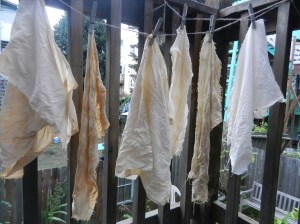Mordanting processes this time are more complicated. I have been reading up. Wools and silk are easiest.
Wools
Alum/cream of tartar: wool is heated, barely simmering, for 1 hour with 20% by weight alum and 15% by weight cream of tartar. The cream of tartar adds acidity that wools (apparently) like. Liquid is cooled and wools steeped for however long you want to.
Brass & Copper: plopped into a jar of water that’s been soaking brass and copper fragments for weeks. Sit for however long.
Milk, soy & yogurt: dairy products are diluted one-to-five with water and poured into jars. Yarn plopped on top. Sit for however long.
Silk
The same for all of the above, except for the alum/cream of tartar and the heating. For silk, the cream of tartar is left out and the alum is allowed to cool. Immersing silk in hot liquid can cause the silk to lose its luster… which is one of the things silk is famous for, so you don’t want to f that up.
Cottons: Here’s Where it Gets Complicated
I’m using metal mordants and protein mordants. Apparently, on cotton, metal mordants like a good tannin dip, and protein mordants like a good alum/washing soda dip.
These dips help the mordants to bond with cellulose fibers, which are, apparently, notoriously impervious to mordants. Which I think is why I got such uninspiring colors during all previous dyeing trials using cotton.
“Apparently” is also my new favorite word, given all the “oh, that’s what I did wrongs” I’ve been finding as I read more and more. “Apparently”=”Who knew?”
As mentioned previously, I used acorn tannins from acorns collected in Bidwell Park, in Chico, while on a hike with my niece.Acorns are hulled, ground, then soaked in water overnight. Once well soaked, the meal is strained through mesh or cheesecloth and wrung tightly, which forces the cream-colored tannin out into a catchment bowl. The soak can be repeated, and more tannin extracted, for quite some time. The whole process was super zen, and so satisfying to watch the tannin surface.
Alum, brass & copper: The tannin is heated, cottons are blopped in and steeped overnight, whereupon they are taken out and dried, again overnight. This is followed by two drips/dries in the metal bath of choice.

After one dip in tannin and one dip in metal mordants, brass (left) and copper (right) already look different just slightly different from each other.
Milk, soy & yogurt: I’ve read that almost any protein substance can be used to mordant cotton: nut and seed milks, dairy products, eggs—even blood.
Cottons are boiled in an alum/washing soda solution and steeped overnight. The next day, once thoroughly dry, they’re dipped in the mordant of choice—in this case, milk, soy, or yogurt diluted one-to-five with water. Dipping and drying is repeated, layering on alum and mordant, day after day.
I’ve read three dips is enough, but you can dip back and forth as long as you want to. I’m going to dip until I run out of the alum/washing soda solution I’ve cooked up. Or until I go mad. It’s a big jar.
Naturally, once you’ve got it all outside, drying on the dye porch, it starts to rain. Luckily, I have the resources to build the Ad Hoc Mordanting Station.
From left to right: alum/tannin, brass/tannin, copper/tannin, milk/alum, soy/alum, and yogurt/alum. Hurrah!





December 28, 2015 at 3:07 am
Lou,
Great efforts. Is this what you were doing over Christmas ?
And it is great to connect what you are doing with nature.
Susie
LikeLike
December 28, 2015 at 12:57 pm
Hi, Susie! Yes, this was my holiday-time project, although once I got it up and running it’s very low maintenance. Just a dip every day, and shake up the jars of yarn once or twice a day. That’s about all I got done as my mother was visiting for a week. And I agree, the gathering of dyestuffs and mordants from parks and backyards and generally beloved places is satisfying and happy-making.
LikeLiked by 1 person
December 28, 2015 at 4:44 pm
You are sweet !
LikeLiked by 1 person
December 29, 2015 at 3:40 pm
‘Blopped in.’ That must be the technical term! 😊
LikeLiked by 1 person
December 29, 2015 at 4:58 pm
Quite! (:
LikeLike
Pingback: Steamt | curvylou
Pingback: Ad Hoc | curvylou
Pingback: Out,… Out, I say! | curvylou